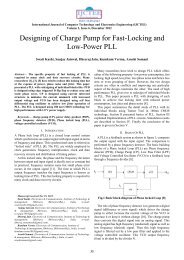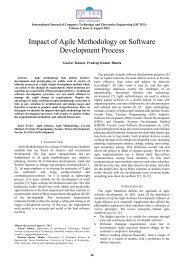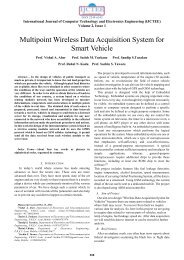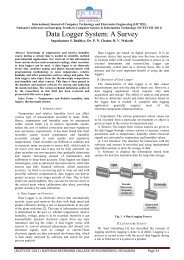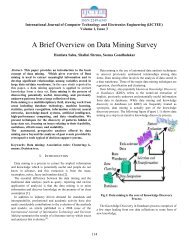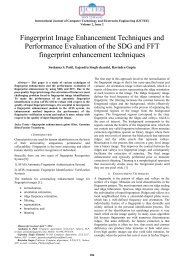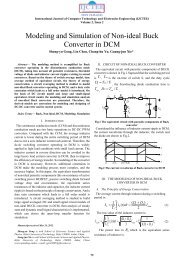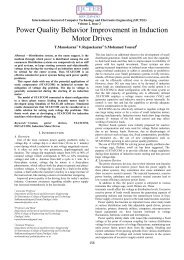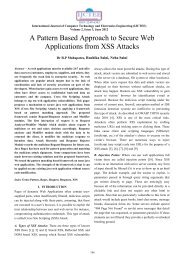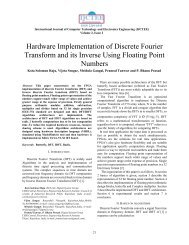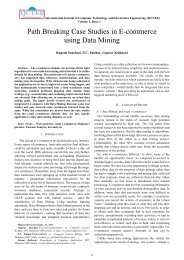Mobile Positioning Techniques in GSM Cellular Networks: A ...
Mobile Positioning Techniques in GSM Cellular Networks: A ...
Mobile Positioning Techniques in GSM Cellular Networks: A ...
You also want an ePaper? Increase the reach of your titles
YUMPU automatically turns print PDFs into web optimized ePapers that Google loves.
ISSN 2249-6343International Journal of Computer Technology and Electronics Eng<strong>in</strong>eer<strong>in</strong>g (IJCTEE)Volume 2, Issue 6, December 2012This paper makes a comparative and analytic study of thevarious techniques for mobile position<strong>in</strong>g and presentsthe limitations of each and the performance of eachmethod based on some performance <strong>in</strong>dices that will beused <strong>in</strong> the analysis.II. PERFORMANCE INDICES FOR MOBILE LOCATIONTECHNIQUESThe comparative analysis of the techniques will be doneunder the follow<strong>in</strong>g matrices:Reliability: simply put is the mean time between failuresand the mean time to repair.Generally a uniform measurement for reliability isdifficult to def<strong>in</strong>e due to the variations <strong>in</strong> technologies. InGPS systems, reliability is def<strong>in</strong>ed as a measure of howconsistent a GPS horizontal error levels can bema<strong>in</strong>ta<strong>in</strong>ed below a specified reliability threshold. Inmobile position<strong>in</strong>g methods, we can simply def<strong>in</strong>ereliability as the ratio of successful position<strong>in</strong>g attemptsout of all attempts made. Systems used <strong>in</strong> personalposition<strong>in</strong>g should uncompromis<strong>in</strong>gly give extremelyreliable performance especially <strong>in</strong> emergency cases s<strong>in</strong>cefailure could be very detrimental. This is an important<strong>in</strong>dicator of performance because a position<strong>in</strong>g devicethat frequently fails or gives false positions will not beseen as trustworthy by the users [4].Latency:Latency measure is basically the time from power-up tothe <strong>in</strong>stant when the first location measurement isobta<strong>in</strong>ed. In GPS, this is known as the time-to-first-fix(TTFF). The high demand for low or short latency is notonly realized <strong>in</strong> the emergency cases but also from theLBS po<strong>in</strong>t of view. Example, the QoS and usability ofguidance and track<strong>in</strong>g applications decreases if onecannot guarantee a real-time operation. Short latency alsosaves power. It is measured <strong>in</strong> seconds. Latency is furtherbroken down <strong>in</strong>to three ma<strong>in</strong> components by def<strong>in</strong><strong>in</strong>g thecall set-up delay, network delay and the process<strong>in</strong>g delay.Briefly, call set-up delay is the time elapsed between call<strong>in</strong>itiation at the MS and receiv<strong>in</strong>g the first response fromthe network. Network delay is def<strong>in</strong>ed as the time neededto transmit all messages exclud<strong>in</strong>g call set-up delay.Process<strong>in</strong>g delay as the name implies is the time neededby the position<strong>in</strong>g device to measure and calculate theposition [5].Applicability:Basically applicability measures the physical limitationsand requirements associated with the implementation anduse of certa<strong>in</strong> technology <strong>in</strong> terms of technical andf<strong>in</strong>ancial issues]. The key issues affect<strong>in</strong>g theapplicability of mobile position<strong>in</strong>g methods are powerconsumption, hardware size, software size, process<strong>in</strong>gload, supported position<strong>in</strong>g modes, network dependency,signal load, cost and standardization. [6].22Accuracy and Precision: Location accuracy of ageolocation method is def<strong>in</strong>ed to be the distance betweenthe estimated location and the true location of the mobilestation. It def<strong>in</strong>es how close the location measurementsare to the actual location of the mobile station be<strong>in</strong>glocated. Accuracy is expressed <strong>in</strong> meters.A location system should report locations accurately andconsistently from measurement to measurement. Inevaluat<strong>in</strong>g the accuracy of a position<strong>in</strong>g device, one hasto consider how many location measurements are made,how location measurements are scored and <strong>in</strong> what formthe results are presented. There are a number ofperformance metrics for location accuracy <strong>in</strong> theliterature. Root Mean Square Error (RMSE), MeanSquared Error (MSE), Circular Error Probability (CEP),and Cramer-Rao Lower Bound (CRLB). A widely usedscore function <strong>in</strong> accuracy evaluation of multiple locationmeasurements is the square root of the mean of squarederrors (RMSE), where RMSE is given by:AndWhere (X est , Y est ) is the estimated coord<strong>in</strong>ates, and(X true ,Y true ) is the true location coord<strong>in</strong>ates of the mobilestation. Where d is are distance errors and n denotes thenumber of location estimates. RMSE is the mostapplicable location accuracy performance metric <strong>in</strong> theliterature. It is the most used and a simple metric.Table 1.Grad<strong>in</strong>g of accuracy levelsAccuracyMarg<strong>in</strong> of errorLowGreater than 150mMedium50 to 150mHigh Less than 50m.Cost: We can assess the cost of a location-sens<strong>in</strong>g system<strong>in</strong> several ways. Time costs <strong>in</strong>clude factors such as the<strong>in</strong>stallation process's length and the system adm<strong>in</strong>istrationneeds. Space costs <strong>in</strong>volve the amount of <strong>in</strong>stalled<strong>in</strong>frastructure and the hardware's size and form factor.Limitations: Some systems will not function <strong>in</strong> certa<strong>in</strong>environments. This limitation has implications for thek<strong>in</strong>d of applications we can build.Coverage: coverage <strong>in</strong> telecommunications systems isrelated to the service area where, at a bare m<strong>in</strong>imum,access to the wireless network is possible. For the mobilelocation techniques under consideration <strong>in</strong> this paper,coverage corresponds to the availability of a sufficientnumber of measurements to perform a locationcomputation
ISSN 2249-6343International Journal of Computer Technology and Electronics Eng<strong>in</strong>eer<strong>in</strong>g (IJCTEE)Volume 2, Issue 6, December 2012III. PERFORMANCE ANALYSIS OF TECHNIQUESThere are numerous techniques that can be considered foruse <strong>in</strong> wireless position location systems. However, wewill discuss only those techniques that can be practically<strong>in</strong>corporated <strong>in</strong> the <strong>GSM</strong> cellular-type systems. Suchtechniques can be broadly classified <strong>in</strong>to two categories.Either the position location system will require amodification <strong>in</strong> the exist<strong>in</strong>g handsets or the system can bedesigned <strong>in</strong> such a way that all the modifications takeplace at the base stations or the switch<strong>in</strong>g centre with nomodifications <strong>in</strong> the exist<strong>in</strong>g handsets.From a physical localization po<strong>in</strong>t of view, all thetechniques discussed <strong>in</strong> this paper will be exam<strong>in</strong>ed anddist<strong>in</strong>guished under the follow<strong>in</strong>g pr<strong>in</strong>cipal techniques.(1) Signal strength and network parameters(2) Triangulation/Trilateration(3) Proximity(4) <strong>GSM</strong> f<strong>in</strong>ger pr<strong>in</strong>t<strong>in</strong>g/database correlationmethod.Signal strength and network parameters basedtechniques.(a) The Cell ID :Accuracy is based on coverage radius of serv<strong>in</strong>g cell, andtherefore is much better <strong>in</strong> urban environments andranges from 300 m to 20km. In this method, accuracylevel is dependent on factors such as cell size, cell type(Omni-directional or sectored), among other factor.However, there is no way to determ<strong>in</strong>e whether the useris, say 15 kilometres north, east, south or west of theserv<strong>in</strong>g base station. In areas where towers are closetogether, users can be located more precisely, as the rangeof each tower is smaller. In rural areas, however, wherethere are fewer towers and the range of each tower isgreater, the degree of accuracy is much less.Its ma<strong>in</strong> advantage is that it supports legacy handsets androam<strong>in</strong>g subscribers. The lager the number of antenna’sprovid<strong>in</strong>g the sector <strong>in</strong>formation <strong>in</strong> the sectored type, themore accurate the location of the device will be. Here thehandset’s location is calculated us<strong>in</strong>g mathematicalalgorithms.(b) Tim<strong>in</strong>g Advance and Round Trip Time:Another primitive location estimation method is theTim<strong>in</strong>g Advance (TA) <strong>in</strong> <strong>GSM</strong> andRound Trip Time <strong>in</strong> 3G systems. The TA is a measure ofthe handset range from a BTS (Base Transceiver Station),and has a resolution of 550m. It improves accuracy level<strong>in</strong> larger (Omni-directional and sectored) cells, as <strong>in</strong><strong>GSM</strong> 900. With TA, the handset registers with at leastthree base stations which send out a tim<strong>in</strong>g signal, forwhich the handset sends back a result to the network for aposition calculation.The Round Trip Time (RTT) of the signal between themobile and the serv<strong>in</strong>g base station can be used to get aradial distance measurement. The <strong>in</strong>tersection of thecircle with radius equal to half the RTT and thehyperbolic curve <strong>in</strong>dicates the position of the mobile.(c) Received Signal Strength Indication (RSSI):This is a network‐Based method of locat<strong>in</strong>g which usesthe Cell ID of the serv<strong>in</strong>g base station of the MS. Thistechnique makes no explicit attempt to resolve theposition of the mobile device beyond <strong>in</strong>dicat<strong>in</strong>g the cellwith which the mobile device is (or has been) registered.When applied to 802.11 systems, this technique tracks thecell to which a mobile device associates. The Cell-ID isthen converted to a geographic position us<strong>in</strong>g knowledgeof the operator’s network, such as coverage database atthe serv<strong>in</strong>g mobile location centre (SMLC). It has a Lowcost of implementation. It is the most primitive method oflocat<strong>in</strong>g a wireless user and does not requireenhancements to be made to the network <strong>in</strong>frastructure orto the <strong>in</strong>dividual handset. It is, however, the least accurateof all location-identification technologies and does notmeet the requirements of Phase II of the E911 Act.Received Signal Strength (RSS) is used to calculate thedistance between transmitter and receiver based onknown transmitter power and transmitter location, and anappropriate path loss model. More realistic mobilecommunications channel model such as Okumura‐HataModel, can be used to convert the signal strengthmeasurements <strong>in</strong>to distance.In this method, Radial distance from reference po<strong>in</strong>ts isused to construct <strong>in</strong>tersect<strong>in</strong>g circles.Triangulation/ Trilateration:In trigonometry and elementary geometry, triangulation isthe process of f<strong>in</strong>d<strong>in</strong>g a distance to a po<strong>in</strong>t by calculat<strong>in</strong>gthe length of one side of a triangle formed by that po<strong>in</strong>tand two other reference po<strong>in</strong>ts, given measurements ofsides and angles of the triangle. Such trigonometricmethods used for position determ<strong>in</strong>ation can bedist<strong>in</strong>guished as:23
ISSN 2249-6343International Journal of Computer Technology and Electronics Eng<strong>in</strong>eer<strong>in</strong>g (IJCTEE)Volume 2, Issue 6, December 2012- Distance –based (tri)-lateration (example: Global<strong>Position<strong>in</strong>g</strong> System, GPS). For distance-basedlateration, the position of an object is computedby measur<strong>in</strong>g its distance from multiplereference po<strong>in</strong>ts.- Angle or direction based (tri)- angulations(example: AOA, TDOA, EOTD)(a) GPSdifficult <strong>in</strong> heavily shadowed and covered urbanenvironments and impossible for <strong>in</strong>door and undergroundcalls. All of these factors make it extremely unlikely thata GPS-based solution will be used to solve the positionlocation challenge <strong>in</strong> cellular-type systems. However, <strong>in</strong>vehicle based mobile phones, GPS is a more realisticoption as it can be permanently <strong>in</strong>stalled <strong>in</strong> the car andmay be used whenever the phone is be<strong>in</strong>g used from thecar.(b) Angle of Arrival (AoA):Fig. 2 A GPS satellite systemOne of the most straightforward solutions to meet theposition location requirements is to use the GPS [7]. Itsaccuracy under ideal conditions, with clear open sky is onthe order of tens of meters (30m‐80m).This technique when applied to cellular phones may<strong>in</strong>volve <strong>in</strong>stall<strong>in</strong>g a complete or a partial GPS receiver <strong>in</strong>the handset and then transmitt<strong>in</strong>g the received GPS dataon the reverse l<strong>in</strong>k to the base station for furtherprocess<strong>in</strong>g and position determ<strong>in</strong>ation. However, numberof factors has made this method undesirable. The totalcost of build<strong>in</strong>g, staff<strong>in</strong>g, ma<strong>in</strong>ta<strong>in</strong><strong>in</strong>g and monitor<strong>in</strong>g asatellite used for location identification purposes isextremely expensive. The satellites currently be<strong>in</strong>g usedhave life spans of 7–15 years, mak<strong>in</strong>g periodicreplacement <strong>in</strong>evitable. Apart from <strong>in</strong>creas<strong>in</strong>g the sizeand weight of the handsets, the GPS receiver would result<strong>in</strong> additional dra<strong>in</strong> for the batteries <strong>in</strong> the mobile phones.This will result <strong>in</strong> reduced talk time which would behighly undesirable. S<strong>in</strong>ce GPS operates <strong>in</strong> L-Band(1575MHz) [8] which is different from either of thecellular or the PCS frequencies, the mobile antennawould need redesign<strong>in</strong>g. All these factors would result <strong>in</strong><strong>in</strong>creased cost for the handset. Another factor weigh<strong>in</strong>gaga<strong>in</strong>st this solution is the “warm-up" time of the GPS.After be<strong>in</strong>g turned on, a GPS receiver takes at least one toone and a half m<strong>in</strong>utes or even longer depend<strong>in</strong>g on thedesign, to start giv<strong>in</strong>g read<strong>in</strong>gs and, hence, this would behighly undesirable for an emergency 911 situation. Tof<strong>in</strong>d the geographical location, the GPS receiver needs tohave at least four satellites visible at all times, which isFig. 3 AOA techniqueAOA methods are sometimes also referred to as Directionof Arrival (DOA) methods. AOA methods utilize multiarrayantennas and try to estimate the direction of arrivalof the signal of <strong>in</strong>terest. Thus a s<strong>in</strong>gle AOA measurementrestricts the source location along a l<strong>in</strong>e <strong>in</strong> the estimatedAOA. If at least two such AOA estimates are availablefrom two antennas at two different locations as shown <strong>in</strong>fig 3 above, the position of the signal source can belocated at the <strong>in</strong>tersection of the l<strong>in</strong>es of bear<strong>in</strong>gs fromthe two antennas. To estimate the AOA, algorithms areused that exploit the phase differences or other signalcharacteristics between closely spaced antenna elementsof an antenna array and employ phase-alignment methodsfor beam/null steer<strong>in</strong>g. AOA works well <strong>in</strong> situationswith direct l<strong>in</strong>e of sight with low likelihood of<strong>in</strong>terference such as sparsely populated areas, but suffersfrom decreased accuracy and precision when confrontedwith signal reflections from surround<strong>in</strong>g objects. In denseurban areas, AOA becomes barely usable because l<strong>in</strong>e ofsight to two or more base stations is seldom present. Theaccuracy of signals us<strong>in</strong>g AOA, however, is limited byvarious forms of signal <strong>in</strong>terference. For example, cityskyscrapers may cause the signal to bounce. If the signalbounces, it is less likely to reach the target, result<strong>in</strong>g <strong>in</strong> aweak signal or none at all.24
ISSN 2249-6343International Journal of Computer Technology and Electronics Eng<strong>in</strong>eer<strong>in</strong>g (IJCTEE)Volume 2, Issue 6, December 2012Another factor is the considerable cost of <strong>in</strong>stall<strong>in</strong>gantenna arrays consider<strong>in</strong>g that these antennas are atneeded at the base station. Although adaptive antennashold considerable promise for improv<strong>in</strong>g the capacity ofcellular systems, they would only be needed <strong>in</strong> the areaswhere capacity enhancement will be required. Hence, forrural and suburban areas which are sparsely populated,this would be a costly solution to meet the E-911requirements. Even if antenna arrays are <strong>in</strong> place at somebase stations, the position location system may needregular calibration s<strong>in</strong>ce a m<strong>in</strong>ute change <strong>in</strong> the physicalarrangement of the array because of w<strong>in</strong>ds or storms, mayresult <strong>in</strong> considerable position location error as theabsolute angular position of the array is used as areference for the AOA estimates.TOA trilateration makes use of three sensors to allow themobile device location to be resolved with improvedaccuracy. A drawback of the TOA approach is therequirement for precise time synchronization of allstations, especially the mobile device (which can be adaunt<strong>in</strong>g challenge for some 802.11 client deviceimplementations) . Given the high propagation speeds,very small discrepancies <strong>in</strong> time measurement error assmall as 100 nanoseconds can result <strong>in</strong> a localizationerror of 30 meters. TOA-based position<strong>in</strong>g solutions aretypically challenged <strong>in</strong> environments where a largeamount of multipath, <strong>in</strong>terference, or noise may exist.TOA techniques are more susceptible to errors frommultiple reflections than the hyperbolic method.(a) Time of Arrival (TOA)(b) TDOA.Fig. 4 TOA techniqueTime of arrival systems are based on the precisemeasurement of the arrival time of a signal transmittedfrom a mobile device to several receiv<strong>in</strong>g sensors.Because signals travel with a known velocity(approximately the speed of light (c) or approximately300 meters per microsecond), the distance between themobile device and each receiv<strong>in</strong>g sensor can bedeterm<strong>in</strong>ed from the elapsed propagation time of thesignal travell<strong>in</strong>g between them. The TOA techniquerequires very precise knowledge of the transmission starttime(s), and must ensure that all receiv<strong>in</strong>g sensors as wellas the mobile device are accurately synchronized with aprecise time source.From the knowledge of both propagation speed andmeasured time, it is possible to calculate the distance (D)between the mobile device and the receiv<strong>in</strong>g station.D=c(t).Where: D= distance (meters)c= propagation speed of approx. 300 meters /microsecondt= time <strong>in</strong> microsecondsWith distance used as a radius, a circular representationof the area around the receiv<strong>in</strong>g sensor can be constructedfor which location of mobile device is highly probable.Fig. 5It is obvious that even small errors <strong>in</strong> the click at thetransmitt<strong>in</strong>g or the receiv<strong>in</strong>g end causes a major error <strong>in</strong>the distance estimate. Usually the mobile unit cannot besynchronized accurately enough to directly obta<strong>in</strong> thetime used by the signal to travel between a mobile unitand a base station. One solution to get around thesynchronization problem is to use differences <strong>in</strong> the timedelays of several base stations <strong>in</strong>stead of absolute times.The Time‐Difference‐Of‐Arrival (TDOA) is measuredbetween multiple pairs of reference po<strong>in</strong>ts with knownlocations. Each TDOA measurement yields a hyperboliccurve on which the mobile may reside. The <strong>in</strong>tersectionof multiple curves produces the location estimate.If only two base stations are available, then only onehyperbolic curve is produced based on the TDOA.TDOA measurements do not require preciselysynchronized clocks at the fixed location receivers [9].This corresponds to the tim<strong>in</strong>g standards already providedat cellular base station sites, mak<strong>in</strong>g TDOA more realisticthan requir<strong>in</strong>g each mobile unit to have an accurate clock.25
ISSN 2249-6343International Journal of Computer Technology and Electronics Eng<strong>in</strong>eer<strong>in</strong>g (IJCTEE)Volume 2, Issue 6, December 2012Atomic clocks, such as a Cesium time source or a GPSreceiver clock, are typically used for tim<strong>in</strong>g at basestations. Hence, it is concluded that the TDOA techniqueappears to be the most feasible option for the wireless E-911 solution.Furthermore, this method offers many advantages overother compet<strong>in</strong>g techniques. S<strong>in</strong>ce all the process<strong>in</strong>gtakes place at the <strong>in</strong>frastructure level; no modificationsare needed <strong>in</strong> the exist<strong>in</strong>g handsets. In this respect, thissolution would be more cost effective than a GPS-basedsolution. It also does not require knowledge of theabsolute time of the transmission from the handset like amodified handset TOA method needs. S<strong>in</strong>ce thistechnique does not require any special type of antennas, itis cheaper to put <strong>in</strong> place than the DOA f<strong>in</strong>d<strong>in</strong>g methods.It can also provide some immunity aga<strong>in</strong>st tim<strong>in</strong>g errorsif the source of major signal reflections is near themobile. If a major reflector affects the signal componentsgo<strong>in</strong>g to all the receivers, the tim<strong>in</strong>g error may getcancelled or reduced <strong>in</strong> the time difference operation.Hence, TDOA methods may work accurately <strong>in</strong> somesituations where there is no LOS signal component. Inthis respect, it is superior to the DOA method or the TOAmethod.The required changes to <strong>in</strong>corporate the TDOA methodare only to be <strong>in</strong> the software of the system.them to the SMLC. E-OTD accuracy is dependent on celldensity, cell plan, multi-path, <strong>in</strong>terference, noise, LMUperformance, and cell site position accuracy. In thistechnique the accuracy does not degrade much <strong>in</strong>doors,and it performs well <strong>in</strong> high base stations density areas.Conversely, E-OTD performance is degraded <strong>in</strong> areaswith low base stations density. It is an Expensive solutionfor operators with accuracy rang<strong>in</strong>g from 50m to 500mand latency around 5s.Proximity:(a) Enhanced Observed Time Difference of ArrivalE-OTD.Cambridge <strong>Position<strong>in</strong>g</strong> Systems, a proponent of the E-OTD system, offers a product with position<strong>in</strong>g accuracywith<strong>in</strong> 50 meters. This time-based technique requireslocation receivers <strong>in</strong> the network <strong>in</strong>frastructure called aLocation Measurement Unit (LMU), and operates us<strong>in</strong>gtime measurements of signal travell<strong>in</strong>g distances betweenthe MS and the LMU as <strong>in</strong> the TDOA technique. Every30 seconds, each base station broadcasts a signal <strong>in</strong> anasynchronous manner.When signals from at least three base stations arereceived by the handset and LMU, the time differences ofarrivals of the signal from each base station at the handsetand the LMU are calculated. The differences <strong>in</strong> timestamps are comb<strong>in</strong>ed to produce <strong>in</strong>tersect<strong>in</strong>g hyperbolicl<strong>in</strong>es and f<strong>in</strong>ally the location estimate of the MS isdeterm<strong>in</strong>ed by the <strong>in</strong>tersection of the hyperbolas.The LMUs help to determ<strong>in</strong>e the clock offsets betweenbase stations. One LMU is needed for every 3 to 5 basestations. However, the cell towers <strong>in</strong>itiate thetransmission to the handset and LMU, not vice versa. TheLocation Measurement Units (LMUs) are essentiallymodified mobile devices, optionally with a GPS receiver,placed <strong>in</strong> a fixed geographical position, with thecapability to perform E -OTD measurements and return26Fig 6In this technique, <strong>Mobile</strong> position location is determ<strong>in</strong>edby assign<strong>in</strong>g the coord<strong>in</strong>ates of a known location that is“close” to the mobile. This known location could be aBase station serv<strong>in</strong>g cell or the closest WiFi access po<strong>in</strong>t.It can also use the <strong>in</strong>tersection of multiple overlapp<strong>in</strong>gareas to improve accuracy.F<strong>in</strong>ger pr<strong>in</strong>t<strong>in</strong>g/database correlationThis technique utilizes the distant RF patterns (multipathphase and amplitude characteristics) of the radio signalsarriv<strong>in</strong>g at a receiver antenna from a s<strong>in</strong>gle caller. Theunique characteristics of the signal, <strong>in</strong>clud<strong>in</strong>g itsmultipath pattern are analyzed and a “f<strong>in</strong>gerpr<strong>in</strong>t” isdeterm<strong>in</strong>ed for a def<strong>in</strong>ed area. The f<strong>in</strong>gerpr<strong>in</strong>t is thencompared with a database of previously “f<strong>in</strong>gerpr<strong>in</strong>ted”locations, and match is made. By match<strong>in</strong>g the f<strong>in</strong>gerpr<strong>in</strong>tof the caller’s signal with the database of knowf<strong>in</strong>gerpr<strong>in</strong>ts, the caller’s geographical location isidentified to one of the surveyed areas”. It has beenshown that an accuracy of 44m is possible <strong>in</strong> <strong>GSM</strong>networks.
LocationtechnologyTOATDOAAOARSSISSN 2249-6343International Journal of Computer Technology and Electronics Eng<strong>in</strong>eer<strong>in</strong>g (IJCTEE)Volume 2, Issue 6, December 2012Observed<strong>in</strong>formationPropagation time ofreceived signalTime of arrival ofsignals emitted atthe same timeAngle of <strong>in</strong>cidenceof received signalStrength of thereceived signalTable 3: Tabular presentation of results from <strong>in</strong>dicesSuitableenvironmentUrban andsuburbanUrban andsuburbanRural areas andareas where directLOS is availableUrban and <strong>in</strong>doorAdvantages Disadvantages OthersHigh accuracy isachievable where thereis coherent detection-<strong>in</strong> the case wherethere is coherentdetection, a highaccuracy can beachieved-the receiver does notneed the time oftransmission-requires nomodification to thehandset.-requires nosynchronizationbetween MS and BS.-simple computation-<strong>in</strong>dependent of radiosystem-requires nosynchronization withBS-<strong>in</strong>volves simplecalculations-low implementationcost-it is <strong>in</strong>dependent ofradio systems-no synchronization forbase Station is required-GPS Outdoors Requires no change tonetwork <strong>in</strong>frastructure,-Synchronizationis required-it is expensive-It <strong>in</strong>volvescomplexcalculations.-expensive toimplement-Offers lowaccuracy <strong>in</strong>large cells.-High cost of<strong>in</strong>stall<strong>in</strong>g arrayantennaOffers lowaccuracy <strong>in</strong> lowcells-High batteryusage,-lacks <strong>in</strong>doorcoverage, andcoverage <strong>in</strong>denselypopulated areas-long signalacquisition timeE-OTD Urban/suburban -subject tourbanmultipathproblems-requires LMU<strong>in</strong> the network<strong>in</strong>frastructurePrivacy isnetworkcontrolledPrivacy isnetworkcontrolledPrivacy isnetworkcontrolled-privacy isusercontrolled.-changes <strong>in</strong>handset are<strong>in</strong>evitable..27
ISSN 2249-6343International Journal of Computer Technology and Electronics Eng<strong>in</strong>eer<strong>in</strong>g (IJCTEE)Volume 2, Issue 6, December 2012IV. CONCLUSIONA brief summary of the results of the analysis is presented<strong>in</strong> the table 4 below.A major element is that the resolution of the locationmethod typically depends on the size of the cells used. Inand around the cities, the cell sizes tend to be small, sothat the mobile station can be tracked with a reasonableaccuracy. Unfortunately <strong>in</strong> a rural area where there is asmall population and a low usage of the network, the typeof cell to be used will be a large macro cell with a largecoverage area, as there are no other cells with<strong>in</strong> range toperform a handover, which gives <strong>in</strong>formation onneighbour<strong>in</strong>g cell. Thus the location f<strong>in</strong>d<strong>in</strong>g methodsoften give poor accuracies <strong>in</strong> the rural areas. A-GPSmethods are obviously the best techniques for locat<strong>in</strong>g themobile station, but it does suffer when there is poor radioreception, especially with<strong>in</strong> build<strong>in</strong>gs [10]. As has beenseen, A-GPS suffers from poor coverage <strong>in</strong> urbanenvironments and also with<strong>in</strong> build<strong>in</strong>gs.Table 4: Summary of resultsLocationTechnologyCategory Accuracy Cost Latency Coverage WirelessstandardReliabilityApplicabilityCell IDCell ID + SSAOATOANetworkbasedNetworkbasedNetworkbasedNetworkbased300m-200m200m-11km100m- Moderate Moderate,200m,,≈10sdecreaseswith<strong>in</strong>creas<strong>in</strong>gdistancebetweenMS and BS50m-200m Low Moderate,
ISSN 2249-6343International Journal of Computer Technology and Electronics Eng<strong>in</strong>eer<strong>in</strong>g (IJCTEE)Volume 2, Issue 6, December 2012References[1] Wireless Geolocation System Architecturewww.cw<strong>in</strong>s.wpi.edu/publications/pown/chapter_14.pdf[2] “FCC Report and Order and Further Notice of ProposedRule Mak<strong>in</strong>g", FCC Docket96-264, June 1996.[3] Mika Keski-Heikkilä, “End-user Location <strong>in</strong> Digital <strong>Mobile</strong><strong>Networks</strong>”. S-72.333 Post-Graduate Course <strong>in</strong> RadioCommunications2001-2002. 19th February, 2002[4] WJ Buchanan, J.Munoz, R.Manson, , K Raja, ”Analysis andMigration of Location-F<strong>in</strong>d<strong>in</strong>g Methods for <strong>GSM</strong> and 3G<strong>Networks</strong>”.[5] Isaac K Adusei, K. Kyamakya, Klaus Jobmann. “<strong>Mobile</strong><strong>Position<strong>in</strong>g</strong> Technologies <strong>in</strong> <strong>Cellular</strong> <strong>Networks</strong>: AnEvaluation of their Performance Metrics”University ofHannover Institute of Communications Eng<strong>in</strong>eer<strong>in</strong>g,Hannover – Germany. 2002[6] L. Lopes, E. Viller, B. Ludden, “<strong>GSM</strong> standards Activity onlocation”. IEE Colloquium on novel methods of Locationand track<strong>in</strong>g of cellular mobiles and their systemsApplications. 1999.[7] Muhammad Aatique,” Evaluation of TDOA <strong>Techniques</strong> forPosition Location <strong>in</strong> CDMA Systems”. Thesis submitted tothe Faculty of the Virg<strong>in</strong>ia Polytechnic Institute and StateUniversity, September 1997[8] Jim Costabile,” Wireless Position Location”. Virg<strong>in</strong>ia TechWireless Symposium, June 4, 2010[9] Benjam<strong>in</strong> Woodacre, “TDOA <strong>Position<strong>in</strong>g</strong> Algorithms:Evaluation and Implementation”September 23, 2003[10] Hakan Senturk, “Performance Evaluation of HyperbolicPosition Location Technique <strong>in</strong> <strong>Cellular</strong> Wireless<strong>Networks</strong>”. Thesis Presented to the Faculty of the GraduateSchool of Eng<strong>in</strong>eer<strong>in</strong>g and Management of the Air ForceInstitute of Technology, March 200229




